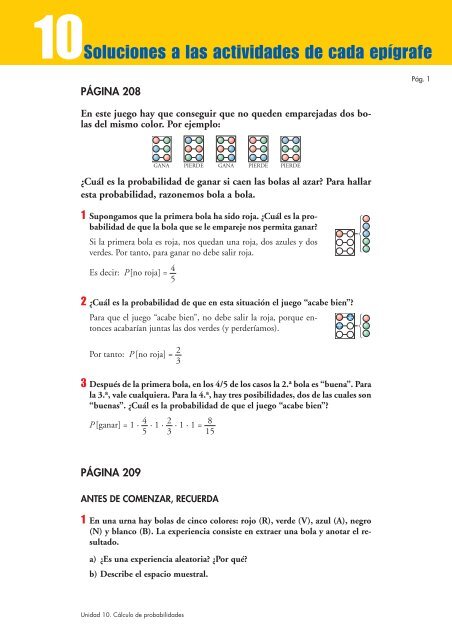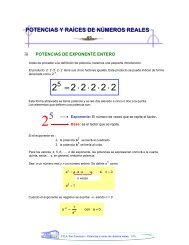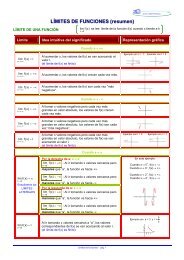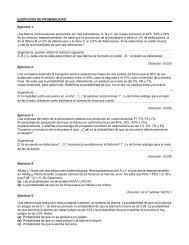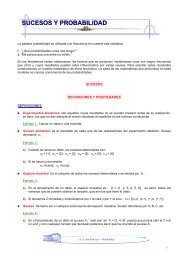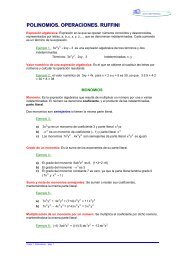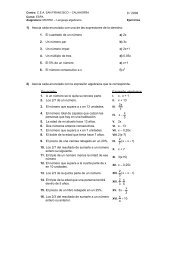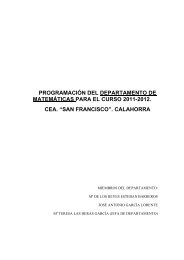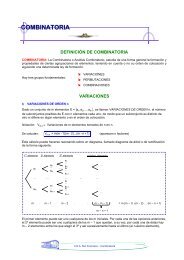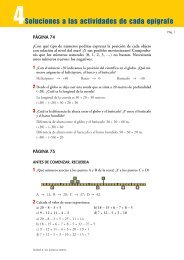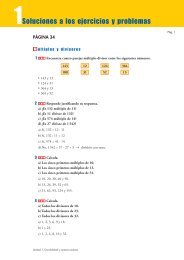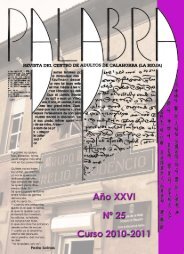10Soluciones a las actividades de cada epígrafe
10Soluciones a las actividades de cada epígrafe
10Soluciones a las actividades de cada epígrafe
You also want an ePaper? Increase the reach of your titles
YUMPU automatically turns print PDFs into web optimized ePapers that Google loves.
<strong>10Soluciones</strong> a <strong>las</strong> <strong>activida<strong>de</strong>s</strong> <strong>de</strong> <strong>cada</strong> <strong>epígrafe</strong><br />
PÁGINA 208<br />
En este juego hay que conseguir que no que<strong>de</strong>n emparejadas dos bo<strong>las</strong><br />
<strong>de</strong>l mismo color. Por ejemplo:<br />
¿Cuál es la probabilidad <strong>de</strong> ganar si caen <strong>las</strong> bo<strong>las</strong> al azar? Para hallar<br />
esta probabilidad, razonemos bola a bola.<br />
1 Supongamos que la primera bola ha sido roja. ¿Cuál es la probabilidad<br />
<strong>de</strong> que la bola que se le empareje nos permita ganar?<br />
Si la primera bola es roja, nos quedan una roja, dos azules y dos<br />
ver<strong>de</strong>s. Por tanto, para ganar no <strong>de</strong>be salir roja.<br />
Es <strong>de</strong>cir: P[no roja] =<br />
2 ¿Cuál es la probabilidad <strong>de</strong> que en esta situación el juego “acabe bien”?<br />
Para que el juego “acabe bien”, no <strong>de</strong>be salir la roja, porque entonces<br />
acabarían juntas <strong>las</strong> dos ver<strong>de</strong>s (y per<strong>de</strong>ríamos).<br />
Por tanto: P [no roja] =<br />
3 Después <strong>de</strong> la primera bola, en los 4/5 <strong>de</strong> los casos la 2. a bola es “buena”. Para<br />
la 3. a , vale cualquiera. Para la 4. a , hay tres posibilida<strong>de</strong>s, dos <strong>de</strong> <strong>las</strong> cuales son<br />
“buenas”. ¿Cuál es la probabilidad <strong>de</strong> que el juego “acabe bien”?<br />
P [ganar] = 1 ·<br />
4<br />
· 1 ·<br />
2<br />
· 1 · 1 =<br />
8<br />
5 3 15<br />
PÁGINA 209<br />
ANTES DE COMENZAR, RECUERDA<br />
GANA PIERDE GANA PIERDE PIERDE<br />
1 En una urna hay bo<strong>las</strong> <strong>de</strong> cinco colores: rojo (R), ver<strong>de</strong> (V), azul (A), negro<br />
(N) y blanco (B). La experiencia consiste en extraer una bola y anotar el resultado.<br />
a) ¿Es una experiencia aleatoria? ¿Por qué?<br />
b) Describe el espacio muestral.<br />
4<br />
5<br />
2<br />
3<br />
Unidad 10. Cálculo <strong>de</strong> probabilida<strong>de</strong>s<br />
Pág. 1
<strong>10Soluciones</strong> a <strong>las</strong> <strong>activida<strong>de</strong>s</strong> <strong>de</strong> <strong>cada</strong> <strong>epígrafe</strong><br />
c) Di cinco sucesos no elementales.<br />
a) Sí que lo es, porque el resultado <strong>de</strong>pen<strong>de</strong> <strong>de</strong>l azar.<br />
b) E = {R, V, A, N, B}<br />
c) Respuesta abierta. Cualquier suceso con más <strong>de</strong> un elemento es no elemental.<br />
2 En los siguientes sucesos, di cuáles correspon<strong>de</strong>n a experiencias regulares y<br />
asígnales probabilidad:<br />
a) Obtener un 3 al lanzar un dado correcto.<br />
b)Obtener un 3 al lanzar un dado chapucero.<br />
c) Extraer una carta <strong>de</strong> OROS <strong>de</strong> una baraja española.<br />
d)Extraer una bola roja <strong>de</strong> un bote cuya composición <strong>de</strong>sconocemos.<br />
e) Que un cierto asegurado <strong>de</strong> una compañía <strong>de</strong> seguros tenga un acci<strong>de</strong>nte<br />
en el próximo año.<br />
a) Regular. P [3] =<br />
1<br />
b) Irregular.<br />
6<br />
c) Regular. P [OROS] =<br />
10<br />
=<br />
1<br />
d)Irregular.<br />
40 4<br />
e) Irregular.<br />
PÁGINA 210<br />
1 Una bolsa contiene 10 bo<strong>las</strong> numeradas <strong>de</strong>l 1 al 10. La experiencia consiste en<br />
extraer una bola y anotar su número.<br />
a) ¿Cuál es el espacio muestral?<br />
b)Consi<strong>de</strong>ramos los sucesos:<br />
A = “obtener número primo” B = “obtener múltiplo <strong>de</strong> 3”<br />
Escribe los sucesos :<br />
A A' A« B A« A'<br />
B B' A» B A» A'<br />
a) E = {1, 2, 3, 4, 5, 6, 7, 8, 9, 10}<br />
b) A = {2, 3, 5, 7}<br />
A' = {1, 4, 6, 8, 9, 10}<br />
B = {3, 6, 9}<br />
B' = {1, 2, 4, 5, 7, 8, 10}<br />
A « B = {2, 3, 5, 6, 7, 9}<br />
A » B = {3}<br />
A « A' = E<br />
A » A' = Ö<br />
Unidad 10. Cálculo <strong>de</strong> probabilida<strong>de</strong>s<br />
Pág. 2
<strong>10Soluciones</strong> a <strong>las</strong> <strong>activida<strong>de</strong>s</strong> <strong>de</strong> <strong>cada</strong> <strong>epígrafe</strong><br />
2 Lanzamos tres veces una moneda.<br />
a) Escribe todos los sucesos elementales (C, C, C ), (C, C, +), (C, +, C )…<br />
b)Indica cuáles <strong>de</strong> estos sucesos componen el suceso S = “la primera vez salió<br />
cara”.<br />
c) Escribe un suceso que sea incompatible con S.<br />
a) {C, C, C}, {C, C, +}, {C, +, C}, {+, C, C}, {C, +, +}, {+, C, +}, {+, +, C}, {+, +, +}<br />
b) S = {{C, C, C}, {C, C, +}, {C, +, C}, {C, +, +}}<br />
c) S': ”la primera vez salió cruz”.<br />
PÁGINA 211<br />
3 Halla la probabilidad <strong>de</strong> los sucesos A = {3, 4, 5, 6} y A', tanto en el caso <strong>de</strong>l<br />
dado correcto como en el <strong>de</strong>l dado <strong>de</strong>fectuoso <strong>de</strong>l ejemplo anterior.<br />
Dado correcto<br />
P[A] =<br />
4<br />
=<br />
2<br />
; P[A'] = 1 – P[A] =<br />
1<br />
6 3<br />
3<br />
Dado <strong>de</strong>fectuoso<br />
P[A] = P[3] + P[4] + P[5] + P[6] = 0,15 + 0,15 + 0,1 + 0,1 = 0,5<br />
P[A'] = 1 – P[A] = 0,5<br />
PÁGINA 213<br />
1 Lanzamos un dado con forma <strong>de</strong> octaedro, con sus caras numeradas <strong>de</strong>l 1 al 8.<br />
Evalúa estas probabilida<strong>de</strong>s:<br />
a) P [múltiplo <strong>de</strong> 3] b)P[menor que 5]<br />
c) P[número primo] d)P[no múltiplo <strong>de</strong> 3]<br />
a) P[{3, 6}] = =<br />
b) P[
<strong>10Soluciones</strong> a <strong>las</strong> <strong>activida<strong>de</strong>s</strong> <strong>de</strong> <strong>cada</strong> <strong>epígrafe</strong><br />
2 Lanzamos dos dados y anotamos la menor <strong>de</strong> <strong>las</strong> puntuaciones.<br />
a) Escribe el espacio muestral y asígnale probabilidad a <strong>cada</strong> uno <strong>de</strong> los casos.<br />
b)Halla la probabilidad <strong>de</strong>l suceso “la menor puntuación es menor que 4” =<br />
“< 4”.<br />
c) Halla P[no < 4].<br />
a) E = {1, 2, 3, 4, 5, 6}<br />
P[1] =<br />
11<br />
36<br />
P[2] =<br />
9<br />
36<br />
P[3] =<br />
P[4] =<br />
5<br />
36<br />
P[5] =<br />
3<br />
36<br />
P[6] =<br />
b) P[< 4] = P[1] + P[2] + P[3] =<br />
27<br />
=<br />
3<br />
36 4<br />
c) P[no < 4] = 1 – P[< 4] = 1 –<br />
3<br />
=<br />
1<br />
4 4<br />
PÁGINA 214<br />
1 Lanzamos un dado y, <strong>de</strong>spués, sacamos una bola <strong>de</strong> la bolsa.<br />
Estas dos experiencias, ¿son <strong>de</strong>pendientes o in<strong>de</strong>pendientes?<br />
Son in<strong>de</strong>pendientes, porque el resultado <strong>de</strong> sacar una bola <strong>de</strong> la bolsa no <strong>de</strong>pen<strong>de</strong><br />
<strong>de</strong> qué haya salido en el dado.<br />
2 A Lanzamos un dado. Si sale par, extraemos una bola<br />
B <strong>de</strong> la bolsa A. Si sale impar, <strong>de</strong> la B. Las experiencias,<br />
¿son <strong>de</strong>pendientes o in<strong>de</strong>pendientes?<br />
PAR<br />
IMPAR<br />
Son <strong>de</strong>pendientes, porque al ser los contenidos <strong>de</strong> <strong>las</strong> bolsas distintos, el resultado<br />
<strong>de</strong>pen<strong>de</strong> <strong>de</strong> qué bolsa se saque, que <strong>de</strong>pen<strong>de</strong> <strong>de</strong>l valor obtenido al lanzar el dado.<br />
Unidad 10. Cálculo <strong>de</strong> probabilida<strong>de</strong>s<br />
Dado 1<br />
Dado 2<br />
1 2 3 4 5 6<br />
1 1 1 1 1 1 1<br />
2 1 2 2 2 2 2<br />
3 1 2 3 3 3 3<br />
4 1 2 3 4 4 4<br />
5 1 2 3 4 5 5<br />
6 1 2 3 4 5 6<br />
7<br />
36<br />
1<br />
36<br />
Pág. 4
<strong>10Soluciones</strong> a <strong>las</strong> <strong>activida<strong>de</strong>s</strong> <strong>de</strong> <strong>cada</strong> <strong>epígrafe</strong><br />
PÁGINA 215<br />
1 Se extraen 3 cartas con reemplazamiento. Halla:<br />
a) P[AS en 1. a y FIGURA en 2. a y 3. a ]<br />
b)P[3 ASES]<br />
c) P[un AS y dos FIGURAS]<br />
d) P[ningún AS]<br />
a) P[AS en 1. a y FIGURA en 2. a y 3. a ] = P[AS] · P[FIGURA] · P[FIGURA] =<br />
=<br />
4<br />
·<br />
12<br />
·<br />
12<br />
=<br />
1<br />
·<br />
3<br />
·<br />
3<br />
=<br />
9<br />
40 40 40 10 10 10 1 000<br />
b) P [3 ASES] = P [AS] · P [AS] · P [AS] =<br />
4<br />
·<br />
4<br />
·<br />
4<br />
=<br />
40 40 40<br />
c) P [un AS y dos FIGURAS] = 3 · P [AS en 1. a y FIGURA en 2. a y 3. a ] =<br />
= 3 ·<br />
9<br />
=<br />
27<br />
1 000 1 000<br />
3<br />
d) P [ningún AS] =<br />
36<br />
·<br />
36<br />
·<br />
36<br />
=<br />
9<br />
=<br />
729<br />
40 40 40 10 1 000<br />
2 Se lanzan 5 monedas. Halla la probabilidad <strong>de</strong>:<br />
a) 5 caras<br />
b) alguna cruz<br />
C<br />
C<br />
C<br />
1/2<br />
C<br />
1/2<br />
C<br />
1/2 1/2<br />
1/2 1/2 1/2 1/2<br />
+<br />
C<br />
1/2 1/2 1/2 1/2 1/2 1/2 1/2 1/2 1/2 1/2 1/2 1/2 1/2 1/2 1/2 1/2<br />
+ C + C + C + C + C + C + C +<br />
1/2 1/2 1/2 1/2 1/2 1/2 1/2 1/2 1/2 1/2 1/2 1/2 1/2 1/2 1/2 1/2 1/2 1/2 1/2 1/2 1/2 1/2 1/2 1/2 1/2 1/2 1/2 1/2 1/2 1/2 1/2 1/2<br />
+ C + C + C + C + C + C + C + C + C + C + C + C + C + C + C + 5-ª MONEDA<br />
1<br />
2<br />
1<br />
2<br />
1<br />
2<br />
1<br />
2<br />
a) P[CINCO CARAS] = · · · · =<br />
+<br />
1/2 1/2<br />
+<br />
(<br />
b) P[ALGUNA CRUZ] = P[0 CARAS Y 5 CRUCES] + P[1 CARA Y 4 CRUCES] +<br />
Unidad 10. Cálculo <strong>de</strong> probabilida<strong>de</strong>s<br />
C<br />
1<br />
2<br />
)<br />
C<br />
1/2 1/2<br />
1<br />
32<br />
+<br />
+ P[2 CARAS Y 3 CRUCES] + P[3 CARAS Y 2 CRUCES] +<br />
+ P[4 CARAS Y 1 CRUZ] = 1 – P[5 CARAS] = 1 – = 31 1<br />
32 32<br />
+<br />
(<br />
1<br />
10<br />
C<br />
)<br />
3<br />
+<br />
=<br />
1/2 1/2<br />
1<br />
1 000<br />
+<br />
1-ª MONEDA<br />
2-ª MONEDA<br />
3-ª MONEDA<br />
4-ª MONEDA<br />
Pág. 5
<strong>10Soluciones</strong> a <strong>las</strong> <strong>activida<strong>de</strong>s</strong> <strong>de</strong> <strong>cada</strong> <strong>epígrafe</strong><br />
3 Lanzamos 3 monedas. Calcula:<br />
a) P[tres caras]<br />
b)P[ninguna cara]<br />
c) P[alguna cara]<br />
a) P [3 caras] =<br />
1<br />
·<br />
1<br />
·<br />
1<br />
=<br />
1<br />
2 2 2 8<br />
b) P [ninguna cara] =<br />
1<br />
·<br />
1<br />
·<br />
1<br />
=<br />
1<br />
2 2 2 8<br />
c) Hay 3 formas <strong>de</strong> que salga una sola cara: {C, +, +}, {+, C, +}, {+, +, C}.<br />
De la misma forma, hay 3 <strong>de</strong> que salgan dos caras.<br />
P [alguna cara] = 3 · P [una cara] + 3 · P [dos caras] + P [tres caras] =<br />
= 3 ·<br />
1<br />
+ 3 ·<br />
1<br />
·<br />
1<br />
=<br />
7<br />
8 8 8 8<br />
4 Se lanzan dos monedas y un dado. ¿Cuál es la probabilidad <strong>de</strong> obtener cara en<br />
ambas monedas y seis en el dado? ¿Cuál, la <strong>de</strong> obtener cruz en <strong>las</strong> monedas y<br />
par en el dado?<br />
Hacemos el diagrama en árbol:<br />
P [C, C, 6] =<br />
1<br />
·<br />
1<br />
·<br />
1<br />
=<br />
1<br />
P [+, +, (2, 4, 6)] =<br />
1<br />
·<br />
1<br />
·<br />
1<br />
=<br />
2 2 6 24<br />
2 2 2<br />
PÁGINA 217<br />
1/2<br />
1/2<br />
1ª MONEDA<br />
1 Extraemos dos cartas <strong>de</strong> una baraja española. ¿Cuál es la probabilidad <strong>de</strong> que<br />
la primera sea un REY y la segunda un AS?<br />
En la baraja española hay 40 cartas <strong>de</strong> <strong>las</strong> cuales 4 son reyes y 4 son ases.<br />
P[REYYAS] = P[REY] · P[AS SUPUESTO QUE LA 1ª FUE REY] =<br />
C<br />
= · = = 2<br />
4 4 4<br />
40 39 390 195<br />
Unidad 10. Cálculo <strong>de</strong> probabilida<strong>de</strong>s<br />
+<br />
1/2<br />
1/2<br />
1/2<br />
1/2<br />
2ª MONEDA<br />
C<br />
+<br />
C<br />
+<br />
1/6<br />
5/6<br />
1/6<br />
5/6<br />
1/6<br />
5/6<br />
1/6<br />
5/6<br />
DADO<br />
6<br />
No 6<br />
6<br />
No 6<br />
6<br />
No 6<br />
6<br />
No 6<br />
1<br />
8<br />
Pág. 6
<strong>10Soluciones</strong> a <strong>las</strong> <strong>activida<strong>de</strong>s</strong> <strong>de</strong> <strong>cada</strong> <strong>epígrafe</strong><br />
2 Completa el diagrama en árbol <strong>de</strong>l ejercicio resuelto <strong>de</strong> esta página y sobre él halla<br />
P [NINGÚN AS].<br />
1.ª EXTRACCIÓN<br />
4/40<br />
36/40<br />
AS<br />
NO AS<br />
Quedan 39 cartas.<br />
De el<strong>las</strong>, 3 ases<br />
Quedan 39 cartas.<br />
De el<strong>las</strong>, 4 ases<br />
P [NINGÚN AS] =<br />
36<br />
·<br />
35<br />
·<br />
34<br />
=<br />
40 39 38<br />
3 Una urna contiene 5 bo<strong>las</strong> negras y 3 blancas. Extraemos tres bo<strong>las</strong>. ¿Cuál es la<br />
probabilidad <strong>de</strong> que <strong>las</strong> tres sean blancas? ¿Y negras?<br />
N 8 bola negra; B 8 bola blanca<br />
5/8<br />
3/8<br />
P [3 BLANCAS] = · · =<br />
P [3 NEGRAS] = · · = 5<br />
3 2 1 1<br />
8 7 6 56<br />
5 4 3<br />
8 7 6 28<br />
Unidad 10. Cálculo <strong>de</strong> probabilida<strong>de</strong>s<br />
2.ª EXTRACCIÓN<br />
N<br />
B<br />
3/39<br />
36/39<br />
4/39<br />
35/39<br />
357<br />
494<br />
1- a EXTRACCIÓN 2- a EXTRACCIÓN 3- a EXTRACCIÓN<br />
4/7<br />
3/7<br />
5/7<br />
2/7<br />
AS<br />
NO AS<br />
AS<br />
NO AS<br />
N<br />
B<br />
N<br />
B<br />
Quedan 38 cartas.<br />
De el<strong>las</strong>, 2 ases<br />
Quedan 38 cartas.<br />
De el<strong>las</strong>, 3 ases<br />
Quedan 38 cartas.<br />
De el<strong>las</strong>, 3 ases<br />
Quedan 38 cartas.<br />
De el<strong>las</strong>, 4 ases<br />
3/6<br />
3/6<br />
4/6<br />
2/6<br />
4/6<br />
3/6<br />
5/6<br />
1/6<br />
N<br />
B<br />
N<br />
B<br />
N<br />
B<br />
N<br />
B<br />
3.ª EXTRACCIÓN<br />
2/38<br />
36/38<br />
3/38<br />
35/38<br />
3/38<br />
35/38<br />
4/38<br />
34/38<br />
AS<br />
NO AS<br />
AS<br />
NO AS<br />
AS<br />
NO AS<br />
AS<br />
NO AS<br />
Pág. 7
<strong>10Soluciones</strong> a <strong>las</strong> <strong>activida<strong>de</strong>s</strong> <strong>de</strong> <strong>cada</strong> <strong>epígrafe</strong><br />
4 Se extraen, una tras otra, 3 cartas <strong>de</strong> una baraja. ¿Cuál es la probabilidad <strong>de</strong> obtener<br />
BASTOS <strong>las</strong> tres veces?<br />
a) Supón que se extraen con reemplazamiento.<br />
b) Supón que se extraen sin reemplazamiento.<br />
a)<br />
10/40<br />
30/40<br />
P[TRES BASTOS] = P[BASTOS] · P[BASTOS] · P[BASTOS] = · · =<br />
b) P[TRES BASTOS] = P[BASTOS] · P[BASTOS] · P[BASTOS] = · · =<br />
5 Una urna A tiene tres bo<strong>las</strong> blancas y una negra. Otra B tiene una bola negra.<br />
Sacamos una bola <strong>de</strong> A y la echamos en B. Removemos y sacamos una bola <strong>de</strong><br />
B. ¿Cuál es la probabilidad <strong>de</strong> que esta sea blanca?<br />
Hacemos un diagrama en árbol:<br />
P [BLANCA] = · + · 0 = 3<br />
3 1 1<br />
4 2 4 8<br />
1- a EXTRACCIÓN 2- a EXTRACCIÓN 3- a EXTRACCIÓN<br />
BASTOS<br />
NO BASTOS<br />
Unidad 10. Cálculo <strong>de</strong> probabilida<strong>de</strong>s<br />
10/40<br />
30/40<br />
10/40<br />
30/40<br />
3/4<br />
1/4<br />
BASTOS<br />
NO BASTOS<br />
BASTOS<br />
NO BASTOS<br />
B<br />
N<br />
1/2<br />
1/2<br />
0<br />
1<br />
10/40<br />
30/40<br />
10/40<br />
30/40<br />
10/40<br />
30/40<br />
10/40<br />
30/40<br />
B<br />
N<br />
B<br />
N<br />
BASTOS<br />
NO BASTOS<br />
BASTOS<br />
NO BASTOS<br />
BASTOS<br />
NO BASTOS<br />
BASTOS<br />
NO BASTOS<br />
10<br />
40<br />
10<br />
40<br />
10<br />
40<br />
9<br />
39<br />
10<br />
40<br />
8<br />
38<br />
1<br />
64<br />
3<br />
247<br />
Pág. 8
<strong>10Soluciones</strong> a <strong>las</strong> <strong>activida<strong>de</strong>s</strong> <strong>de</strong> <strong>cada</strong> <strong>epígrafe</strong><br />
PÁGINA 219<br />
1 Explica el significado <strong>de</strong> los números 120, 168, 12, 45 y 40 <strong>de</strong> la tabla <strong>de</strong>l ejercicio<br />
resuelto anterior.<br />
120 8 Número <strong>de</strong> alumnos <strong>de</strong> 1.°.<br />
168 8 Número <strong>de</strong> alumnos con NINGUNA actividad extraescolar.<br />
12 8 Número <strong>de</strong> alumnos <strong>de</strong> 1.° con actividad extraescolar CULTURAL.<br />
45 8 Número <strong>de</strong> alumnos <strong>de</strong> 2.° con NINGUNA actividad extraescolar.<br />
40 8 Número <strong>de</strong> alumnos <strong>de</strong> 4.° con actividad extraescolar DEPORTIVA.<br />
2 Explica lo que significa, para la tabla <strong>de</strong>l ejercicio resuelto anterior, <strong>cada</strong> una<br />
<strong>de</strong> <strong>las</strong> expresiones siguientes y da su valor:<br />
P[1.°] P[CULTURAL] P[4.°/CULTURAL] P[CULTURAL/4.°]<br />
P [1.°] 8 Probabilidad <strong>de</strong> que, elegido al azar, un alumno sea <strong>de</strong> 1.°.<br />
P [1.°] =<br />
120<br />
= 0,3<br />
400<br />
P[CULTURAL] 8 Probablidad <strong>de</strong> elegir a un alumno con actividad extraescolar<br />
CULTURAL.<br />
P[CULTURAL] =<br />
72<br />
= 0,18<br />
400<br />
P[4.°/CULTURAL] 8 Probabilidad <strong>de</strong> que habiendo elegido un alumno con actividad<br />
CULTURAL, este resulte ser <strong>de</strong> 4.°.<br />
P[4.°/CULTURAL] =<br />
24<br />
= 0,375<br />
72<br />
P[CULTURAL/4.°] 8 Probabilidad <strong>de</strong> elegir a un alumno con actividad CULTURAL<br />
entre todos los <strong>de</strong> 4.°.<br />
P[CULTURAL/4.°] =<br />
24<br />
= 0,3<br />
80<br />
3 Queremos analizar, partiendo <strong>de</strong> los datos <strong>de</strong> la tabla <strong>de</strong>l ejercicio resuelto anterior,<br />
la evolución <strong>de</strong>l absentismo (falta <strong>de</strong> participación) en <strong>activida<strong>de</strong>s</strong> extraescolares<br />
cualesquiera, al aumentar la edad. Calcula <strong>las</strong> proporciones que<br />
convenga y compára<strong>las</strong>.<br />
Debemos observar la probabilidad <strong>de</strong> los que no hacen ninguna actividad en <strong>cada</strong><br />
uno <strong>de</strong> los cursos, es <strong>de</strong>cir:<br />
P [NINGUNA/1.°] =<br />
72<br />
= 0,6 P [NINGUNA/2.°] =<br />
45<br />
= 0,45<br />
120<br />
100<br />
P [NINGUNA/3.°] =<br />
35<br />
= 0,35 P [NINGUNA/4.°] =<br />
16<br />
= 0,2<br />
100<br />
80<br />
Por tanto, según pasan los cursos, <strong>cada</strong> vez hay menos alumnos que no hacen ninguna<br />
actividad extraescolar.<br />
Unidad 10. Cálculo <strong>de</strong> probabilida<strong>de</strong>s<br />
Pág. 9
<strong>10Soluciones</strong> a <strong>las</strong> <strong>activida<strong>de</strong>s</strong> <strong>de</strong> <strong>cada</strong> <strong>epígrafe</strong><br />
4 En una bolsa hay 40 bo<strong>las</strong> huecas, y <strong>de</strong>ntro <strong>de</strong> <strong>cada</strong><br />
una hay un papel en el que pone SÍ o NO.<br />
La distribución <strong>de</strong> bo<strong>las</strong> según colores y SÍ y NO está<br />
en la tabla.<br />
a) Describe los sucesos SÍ, NO, , /SÍ, SÍ/ y calcula sus probabilida<strong>de</strong>s.<br />
b) Hemos sacado una bola roja. ¿Qué probabilidad hay <strong>de</strong> que haya SÍ en su interior?<br />
¿Y si la bola es azul?<br />
c) Se ha sacado una bola y <strong>de</strong>ntro pone SÍ. ¿Cuál es la probabilidad <strong>de</strong> que sea<br />
, o ?<br />
a) SÍ 8 sacar una bola al azar y que sea SÍ.<br />
NO 8 sacar una bola al azar y que sea NO.<br />
8 sacar una bola al azar y sea roja.<br />
/SÍ 8 <strong>de</strong> entre dos bo<strong>las</strong> que dicen SÍ, sacar una roja.<br />
SÍ/ 8 <strong>de</strong> entre <strong>las</strong> bo<strong>las</strong> rojas, sacar una que dice SÍ.<br />
P [SÍ] =<br />
20<br />
=<br />
1<br />
P [NO] = 1 – P [SÍ]=<br />
1<br />
40 2<br />
2<br />
P [ ] =<br />
20<br />
=<br />
1<br />
P [ /SÍ] =<br />
15<br />
=<br />
3<br />
40 2<br />
20 4<br />
P [SÍ/ ] =<br />
15<br />
=<br />
3<br />
20 4<br />
b) P [SÍ/ ] =<br />
15<br />
=<br />
3<br />
20 4<br />
P [SÍ/ ] =<br />
1<br />
12<br />
c) P [ /SÍ] = =<br />
P [ /SÍ] = =<br />
P [ /SÍ] = 1<br />
15 3<br />
20 4<br />
4 1<br />
20 5<br />
20<br />
Unidad 10. Cálculo <strong>de</strong> probabilida<strong>de</strong>s<br />
TOTAL<br />
SÍ 15 4 1 20<br />
NO 5 4 11 20<br />
TOTAL 20 8 12 40<br />
Pág. 10
<strong>10Soluciones</strong> a los ejercicios y problemas<br />
PÁGINA 220<br />
P RACTICA<br />
Relaciones entre sucesos<br />
1 En un sorteo <strong>de</strong> lotería observamos la cifra en que termina el “gordo”.<br />
a) ¿Cuál es el espacio muestral?<br />
b)Escribe los sucesos: A = MENOR QUE 5; B = PAR.<br />
c) Halla los sucesos A « B, A » B, A', B', A' » B'.<br />
a) El espacio muestral es: E = {0, 1, 2, 3, 4, 5, 6, 7, 8, 9}<br />
b) A = “MENOR QUE 5” = {0, 1, 2, 3, 4}<br />
B = “PAR” = {0, 2, 4, 6, 8}<br />
c) A « B = {0, 1, 2, 3, 4, 6, 8}<br />
A » B = {0, 2, 4}<br />
A' = {5, 6, 7, 8, 9}<br />
B' = {1, 3, 5, 7, 9}<br />
A' » B' = {5, 7, 9}<br />
2 Escribimos <strong>cada</strong> una <strong>de</strong> <strong>las</strong> letras <strong>de</strong> la palabra PREMIO en una ficha y <strong>las</strong><br />
ponemos en una bolsa. Extraemos una letra al azar.<br />
a) Escribe los sucesos elementales <strong>de</strong> este experimento. ¿Tienen todos la misma<br />
probabilidad?<br />
b)Escribe el suceso “obtener vocal” y calcula su probabilidad.<br />
c) Si la palabra elegida fuera SUERTE, ¿cómo respon<strong>de</strong>rías a los apartados a) y b)?<br />
a) Los sucesos elementales son: {P}, {R}, {E}, {M}, {I}, {O}.<br />
Todas tienen la misma probabilidad, porque todas aparecen una sola vez.<br />
b) V = “obtener vocal” 8 V = {E, I, O}<br />
P[V] =<br />
3<br />
=<br />
1<br />
6 2<br />
c) Los sucesos elementales son: {S}, {U}, {E}, {R}, {T}<br />
P[V] =<br />
3<br />
=<br />
1<br />
6 2<br />
En este caso el suceso elemental {E} tiene más probabilidad que el resto, por aparecer<br />
dos veces.<br />
3 Lanzamos un dado rojo y otro ver<strong>de</strong>. Anotamos el resultado. Por ejemplo,<br />
(3, 4) significa 3 en el rojo y 4 en el ver<strong>de</strong>.<br />
a) ¿Cuántos elementos tiene el espacio muestral?<br />
b)Describe los siguientes sucesos:<br />
Unidad 10. Cálculo <strong>de</strong> probabilida<strong>de</strong>s<br />
Pág. 1
<strong>10Soluciones</strong> a los ejercicios y problemas<br />
A: la suma <strong>de</strong> puntos es 6; A = {(5, 1), (4, 2), …}<br />
B: En uno <strong>de</strong> los dados ha salido 4; B = {(4, 1), …}<br />
C: En los dados salió el mismo resultado.<br />
c) Describe los sucesos A « B, A » B, A » C.<br />
d)Calcula la probabilidad <strong>de</strong> los sucesos <strong>de</strong> los apartados b) y c).<br />
e) Calcula la probabilidad <strong>de</strong> A', B' y C'.<br />
a) Como tenemos dos dados, <strong>cada</strong> uno con 6 caras, tenemos 6 resultados en uno<br />
para <strong>cada</strong> uno <strong>de</strong> los 6 resultados <strong>de</strong>l otro. Es <strong>de</strong>cir, en total, 36 elementos en el<br />
espacio muestral.<br />
b) A = {(5, 1), (4, 2), (3, 3), (2, 4), (1, 5)}<br />
B = {(4, 1), (4, 2), (4, 3), (4, 4), (4, 5), (4, 6), (1, 4), (2, 4), (3, 4), (5, 4), (6, 4)}<br />
C = {(1, 1), (2, 2), (3, 3), (4, 4), (5, 5), (6, 6)}<br />
c) A « B 8 En uno <strong>de</strong> los dados ha salido un 4 o la suma <strong>de</strong> los dos es 6.<br />
A » B 8 Habiendo salido un 4, la suma <strong>de</strong> los dos es 6, es <strong>de</strong>cir, {(4, 2), (2, 4)}.<br />
A » C 8 Habiendo salido dos números iguales, la suma es 6, es <strong>de</strong>cir, {(3, 3)}.<br />
d) P [A] =<br />
5<br />
P [B] =<br />
11<br />
P [C] =<br />
6<br />
=<br />
1<br />
36<br />
36<br />
36 6<br />
P [A « B] =<br />
14<br />
=<br />
7<br />
P [A » B] =<br />
2<br />
=<br />
1<br />
P [A » C ] =<br />
1<br />
36 18<br />
36 18<br />
36<br />
e) P [A'] = 1 – P [A]=<br />
31<br />
36<br />
P [B'] = 1 – P [B]=<br />
25<br />
36<br />
P [C'] = 1 – P [C]=<br />
5<br />
6<br />
4 El juego <strong>de</strong>l dominó consta <strong>de</strong> 28 fichas. Sacamos una al azar y anotamos<br />
la suma (x) <strong>de</strong> <strong>las</strong> puntuaciones.<br />
a) ¿Cuál es el espacio muestral? Di la probabilidad <strong>de</strong> <strong>cada</strong> uno <strong>de</strong> los 13 casos<br />
que pue<strong>de</strong>n darse.<br />
b)Describe los sucesos:<br />
A: x es un número primo. B: x es mayor que 4. A « B, A » B, A'<br />
c) Calcula <strong>las</strong> probabilida<strong>de</strong>s <strong>de</strong> los sucesos <strong>de</strong>scritos en el apartado b).<br />
a) E = {0, 1, 2, 3, 4, 5, 6, 7, 8, 9,10, 11, 12}<br />
P [0] = ; P[1] = ; P[2] =<br />
P[3] = ; P[4] = ; P[5] = 3<br />
1 1 2<br />
28 28 28<br />
2 3<br />
28 28 28<br />
Unidad 10. Cálculo <strong>de</strong> probabilida<strong>de</strong>s<br />
Pág. 2
<strong>10Soluciones</strong> a los ejercicios y problemas<br />
P[6] =<br />
4<br />
; P[7] =<br />
3<br />
; P[8] =<br />
3<br />
28 28 28<br />
P[9] =<br />
2<br />
; P[10] =<br />
2<br />
; P[11] =<br />
1<br />
; P[12] =<br />
1<br />
28 28 28 28<br />
b) A = {2, 3, 5, 7, 11} B = {5, 6, 7, 8, 9, 10, 11, 12}<br />
A « B = {2, 3, 5, 6, 7, 8, 9, 10, 11, 12}<br />
A' = {1, 4, 6, 8, 9, 10, 12}<br />
A » B = {5, 7, 11}<br />
c) P [A] = P[2] + P[3] + P[5] + P[7] + P[11] =<br />
P[B] =<br />
19<br />
28<br />
P[A « B] =<br />
23<br />
28<br />
P[A » B] =<br />
7<br />
=<br />
1<br />
28 4<br />
P[A'] = 1 – P [A]=<br />
17<br />
28<br />
Probabilida<strong>de</strong>s sencil<strong>las</strong><br />
5 En la lotería primitiva se extraen bo<strong>las</strong> numeradas <strong>de</strong>l 1 al 49. Calcula la<br />
probabilidad <strong>de</strong> que la primera bola extraída :<br />
a) Sea un número <strong>de</strong> una sola cifra.<br />
b)Sea un número múltiplo <strong>de</strong> 7.<br />
c) Sea un número mayor que 25.<br />
a) P [1, 2, 3, 4, 5, 6, 7, 8, 9] =<br />
9<br />
49<br />
b) P [7, 14, 21, 28, 35, 42, 49] =<br />
7<br />
=<br />
49<br />
c) P [26, 27, 28, …, 49] =<br />
24<br />
49<br />
6 Se extrae una carta <strong>de</strong> una baraja española. Di cuál es la probabilidad <strong>de</strong><br />
que sea:<br />
a) REY o AS. b)FIGURA y OROS. c) NO SEA ESPADAS.<br />
a) P [REYOAS] = =<br />
b) P [FIGURA Y OROS] = P [FIGURA DE OROS] = =<br />
c) P [NO SEA ESPADAS] = = 3<br />
8 1<br />
40 5<br />
3 1<br />
40 10<br />
30<br />
40 4<br />
Unidad 10. Cálculo <strong>de</strong> probabilida<strong>de</strong>s<br />
1<br />
7<br />
11<br />
28<br />
Pág. 3
<strong>10Soluciones</strong> a los ejercicios y problemas<br />
7 En una bolsa hay bo<strong>las</strong> <strong>de</strong> colores, pero no sabemos cuántas ni qué colores<br />
tienen. En 1 000 extracciones (<strong>de</strong>volviendo la bola <strong>cada</strong> vez) hemos obtenido<br />
bola blanca en 411 ocasiones, bola negra en 190, bola ver<strong>de</strong> en 179 y bola<br />
azul en 220.<br />
Al hacer una nueva extracción, di qué probabilidad asignarías a:<br />
a) Sacar bola blanca.<br />
b)No sacar bola blanca.<br />
c) Sacar bola ver<strong>de</strong> o azul.<br />
d)No sacar bola negra ni azul.<br />
Si en la bolsa hay 22 bo<strong>las</strong>, ¿cuántas estimas que habrá <strong>de</strong> <strong>cada</strong> uno <strong>de</strong> los colores?<br />
Como se han hecho 1 000 extracciones:<br />
P [BOLA BLANCA] =<br />
411<br />
= 0,411 P [BOLA VERDE] =<br />
179<br />
= 0,179<br />
1 000<br />
1 000<br />
P[BOLA NEGRA] =<br />
190<br />
= 0,19 P [BOLA AZUL] =<br />
220<br />
= 0,22<br />
1 000<br />
1 000<br />
a) P [BOLA BLANCA] = 0,411<br />
b) P [NO BOLA BLANCA] = 1 – 0,411 = 0,589<br />
c) P [BOLA VERDE O AZUL] = 0,179 + 0,22 = 0,399<br />
d) P [NO BOLA NEGRA NI AZUL] = 1 – (0,19 + 0,22) = 0,59<br />
Si hay 22 bo<strong>las</strong>:<br />
• El 41% son blancas 8 22 · 0,41 = 9 bo<strong>las</strong> blancas.<br />
• El 19% son negras 8 22 · 0,19 = 4 bo<strong>las</strong> negras.<br />
• El 18% son ver<strong>de</strong>s 8 22 · 0,18 = 4 bo<strong>las</strong> ver<strong>de</strong>s.<br />
• El 22% son azules 8 22 · 0,22 = 5 bo<strong>las</strong> azules.<br />
8 Ana tira un dado y su hermana Eva lo tira <strong>de</strong>spués. ¿Cuál es la probabilidad<br />
<strong>de</strong> que la puntuación <strong>de</strong> Eva sea superior a la <strong>de</strong> Ana?<br />
ANA<br />
EVA 1 2 3 4 5 6<br />
1 1–1 1–2 1–3 1–4 1–5 1–6<br />
2<br />
3<br />
4<br />
5<br />
2–1 2–2 2–3 2–4 2–5 2–6<br />
3–1 3–2 3–3 3–4 3–5 3–6<br />
4–1 4–2 4–3 4–4 4–5 4–6<br />
5–1 5–2 5–3 5–4 5–5 5–6<br />
6 6–1 6–2 6–3 6–4 6–5 6–6<br />
P [PUNTUACIÓN DE EVA SUPERIOR A LA DE ANA] = = 5 15<br />
36 12<br />
Unidad 10. Cálculo <strong>de</strong> probabilida<strong>de</strong>s<br />
Pág. 4
<strong>10Soluciones</strong> a los ejercicios y problemas<br />
9 Lanzamos dos dados y anotamos la puntuación<br />
<strong>de</strong>l mayor (si coinci<strong>de</strong>n, la <strong>de</strong> uno <strong>de</strong> ellos).<br />
a) Completa la tabla y di <strong>las</strong> probabilida<strong>de</strong>s <strong>de</strong> los<br />
seis sucesos elementales 1, 2, 3, 4, 5 y 6.<br />
b)Halla la probabilidad <strong>de</strong> los sucesos:<br />
a)<br />
A: n.° par, B: n.° menor que 4, A » B.<br />
1<br />
P [1] =<br />
1<br />
; P[2] =<br />
3<br />
=<br />
1<br />
; P[3] =<br />
5<br />
36 36 12 36<br />
P[4] =<br />
7<br />
; P[5] =<br />
9<br />
=<br />
1<br />
; P[6] =<br />
11<br />
36 36 4 36<br />
b) P[A] =<br />
3<br />
+<br />
7<br />
+<br />
11<br />
=<br />
21<br />
=<br />
7<br />
36 36 36 36 12<br />
P[B] =<br />
1<br />
+<br />
3<br />
+<br />
5<br />
=<br />
9<br />
=<br />
1<br />
36 36 36 36 4<br />
P[A » B] = P[2] =<br />
PÁGINA 221<br />
2 3 4 5 6<br />
2 2 3 4 5 6<br />
3 3 3 4 5 6<br />
4 4 4 4 5 6<br />
5 5 5 5 5 6<br />
6 6 6 6 6 6<br />
1<br />
12<br />
Experiencias compuestas<br />
10 a) Tenemos dos barajas <strong>de</strong> 40 cartas. Sacamos una carta <strong>de</strong> <strong>cada</strong> una.<br />
¿Cuál es la probabilidad <strong>de</strong> que ambas sean 7? ¿Cuál es la probabilidad <strong>de</strong> que<br />
ambas sean figuras (sota, caballo o rey)?<br />
b)Tenemos una baraja <strong>de</strong> 40 cartas. Sacamos dos cartas. ¿Cuál es la probabilidad<br />
<strong>de</strong> que ambas sean un 7? ¿Cuál es la probabilidad <strong>de</strong> que ambas sean figura?<br />
a) P [7 y 7] = · =<br />
P [FIGURA y FIGURA] = · = 9<br />
4 4 1<br />
40 40 100<br />
12 12<br />
40 40 100<br />
Unidad 10. Cálculo <strong>de</strong> probabilida<strong>de</strong>s<br />
1<br />
2<br />
2<br />
6<br />
4<br />
5<br />
6<br />
Pág. 5
<strong>10Soluciones</strong> a los ejercicios y problemas<br />
b) P [7 y 7] =<br />
4<br />
·<br />
3<br />
=<br />
12<br />
=<br />
1<br />
40 39 1 560 130<br />
P [FIGURA y FIGURA]=<br />
12<br />
·<br />
11<br />
=<br />
132<br />
=<br />
40 39 1 560<br />
11 Lanzamos tres dados. ¿Cuál es la probabilidad <strong>de</strong> que <strong>las</strong> tres puntuaciones<br />
sean menores que 5?<br />
P [<strong>las</strong> tres menores que 5] = P [menor que 5] · P [menor que 5] · P [menor que 5] =<br />
=<br />
4<br />
·<br />
4<br />
·<br />
4<br />
=<br />
8<br />
6 6 6 27<br />
12 Sacamos una bola <strong>de</strong> <strong>cada</strong> urna. Calcula:<br />
a) La probabilidad <strong>de</strong> que ambas sean rojas.<br />
b)La probabilidad <strong>de</strong> que ambas sean negras.<br />
c) La probabilidad <strong>de</strong> que alguna sea ver<strong>de</strong>.<br />
a) P [ROJA y ROJA] =<br />
3<br />
·<br />
2<br />
=<br />
6<br />
5 5 25<br />
b) P[NEGRA y NEGRA] =<br />
2<br />
·<br />
2<br />
=<br />
4<br />
5 5 25<br />
c) P[alguna VERDE] = P [VERDE] + P [VERDE] = 0 +<br />
1<br />
=<br />
5<br />
13 Sacamos dos bo<strong>las</strong>. Calcula:<br />
a) P[2 rojas]<br />
b)P[2 ver<strong>de</strong>s]<br />
11<br />
130<br />
a) P[2 ROJAS] =<br />
3<br />
·<br />
2<br />
=<br />
3<br />
b) P[2 VERDES] =<br />
2<br />
·<br />
1<br />
=<br />
1<br />
5 4 10<br />
5 4 10<br />
14 Sacamos una bola <strong>de</strong> A, la echamos en B, removemos y sacamos una <strong>de</strong><br />
B. Calcula:<br />
Unidad 10. Cálculo <strong>de</strong> probabilida<strong>de</strong>s<br />
A B<br />
1<br />
5<br />
Pág. 6
<strong>10Soluciones</strong> a los ejercicios y problemas<br />
a) P[1. a roja y 2. a roja] b)P[1. a roja y 2. a ver<strong>de</strong>]<br />
c) P[2. a roja / 1. a ver<strong>de</strong>] d)P[2. a roja / 1. a roja]<br />
e) P[2. a roja] f) P[2. a ver<strong>de</strong>]<br />
☞ e) Para calcular esta probabilidad, ten en cuenta el diagrama.<br />
a) P[1. a roja y 2. a roja] = · =<br />
b) P[1. a roja y 2. a 3 2 2<br />
5 3 5<br />
ver<strong>de</strong>] =<br />
3<br />
·<br />
1<br />
=<br />
1<br />
5 3 5<br />
c) P[2. a roja / 1. a ver<strong>de</strong>] =<br />
d) P[2. a roja / 1. a roja] =<br />
2<br />
3<br />
1<br />
3<br />
e) P[2. a roja] = · + · =<br />
f) P[2. a 3 2 2 1 8<br />
5 3 5 3 15<br />
ver<strong>de</strong>] =<br />
3<br />
·<br />
1<br />
+<br />
2<br />
·<br />
2<br />
=<br />
7<br />
5 3 5 3 15<br />
Tab<strong>las</strong> <strong>de</strong> contingencia<br />
A<br />
15 En un centro escolar hay 1 000 alumnos y<br />
CHICOS CHICAS<br />
alumnas repartidos así:<br />
USAN GAFAS 147 135<br />
Llamamos: A 5 chicas, O 5 chicos, G 5 tiene<br />
NO USAN GAFAS gafas, no G 5 no tiene gafas. Calcula:<br />
368 350<br />
a) P[A], P[O], P[G], P[no G]<br />
b)Describe los siguientes sucesos y calcula sus probabilida<strong>de</strong>s: A y G, O y no<br />
G, A/G, G/A, G/O.<br />
a) P [A] =<br />
135 + 350<br />
=<br />
485<br />
= 0,485<br />
1 000 1 000<br />
P [O] = 1 – P [A] = 1 – 0,485 = 0,515<br />
Unidad 10. Cálculo <strong>de</strong> probabilida<strong>de</strong>s<br />
3<br />
— 5<br />
2<br />
— 5<br />
B<br />
B<br />
2<br />
— 3<br />
1<br />
— 3<br />
3 2<br />
— · —<br />
5 3<br />
2 1<br />
— · —<br />
5 3<br />
Pág. 7
<strong>10Soluciones</strong> a los ejercicios y problemas<br />
P[G] =<br />
147 + 135<br />
=<br />
282<br />
= 0,282<br />
1 000 1 000<br />
P[no G] = 1 – P[G] = 1 – 0,282 = 0,718<br />
b) A y G 8 Chica con gafas.<br />
P[A y G] =<br />
135<br />
= 0,135<br />
1 000<br />
O y no G 8 Chico sin gafas<br />
P[O y no G] =<br />
368<br />
= 0,368<br />
1 000<br />
A/G 8 De los que llevan gafas, cuántas son chicas.<br />
P[A/G] =<br />
135<br />
= 0,479<br />
282<br />
G/A 8 De todas <strong>las</strong> chicas, cuántas llevan gafas.<br />
P[G/A] =<br />
135<br />
= 0,278<br />
485<br />
G/O 8 De todos los chicos, cuántos llevan gafas.<br />
P[G/O] =<br />
147<br />
= 0,285<br />
515<br />
16 En una empresa hay 200 empleados, 100 hombres y 100 mujeres. Los fumadores<br />
son 40 hombres y 35 mujeres.<br />
a) Haz con los datos una tabla <strong>de</strong> contingencia.<br />
b)Si elegimos un empleado al azar, calcula la probabilidad <strong>de</strong> que sea hombre<br />
y no fume: P[H y no F].<br />
c) Calcula también: P[M y F], P[M / F], P[F / M]<br />
a)<br />
HOMBRE MUJER<br />
FUMADOR 40 35<br />
NO FUMADOR 60 65<br />
b) P[H y no F] =<br />
60<br />
= 0,3<br />
200<br />
c) P[M y F] =<br />
35<br />
= 0,175<br />
200<br />
P[M/F] =<br />
35<br />
= 0,467<br />
75<br />
P[F/M] =<br />
35<br />
= 0,35<br />
100<br />
Unidad 10. Cálculo <strong>de</strong> probabilida<strong>de</strong>s<br />
Pág. 8
<strong>10Soluciones</strong> a los ejercicios y problemas<br />
17 Los 1000 socios <strong>de</strong> un club <strong>de</strong>portivo se distribuyen <strong>de</strong> la forma que se<br />
indica en la tabla.<br />
Si se elige una persona al azar, calcula la probabilidad <strong>de</strong> que:<br />
a) Sea un hombre.<br />
b)Sea una mujer.<br />
c) Juegue al baloncesto.<br />
d)Sea una mujer que practique baloncesto.<br />
e) Sea un hombre que no practique baloncesto.<br />
f) Juegue al baloncesto, sabiendo que es hombre.<br />
g) Sea mujer, sabiendo que no juega al baloncesto.<br />
a) P[H] =<br />
147 + 368<br />
=<br />
515<br />
= 0,515<br />
1 000 1 000<br />
b) P[M] = 1 – P[H] = 0,485<br />
c) P[B] =<br />
147 + 135<br />
=<br />
282<br />
= 0,282<br />
1 000 1 000<br />
d) P[M y B] =<br />
135<br />
= 0,135<br />
1 000<br />
e) P[H y no B] =<br />
368<br />
= 0,368<br />
1 000<br />
f) P[B/H] =<br />
147<br />
= 0,285<br />
515<br />
g) P[M/no B] =<br />
350<br />
= 0,487<br />
718<br />
PÁGINA 222<br />
P IENSA Y RESUELVE<br />
18 Una urna contiene 100 bo<strong>las</strong> numeradas así: 00, 01, 02 … 99<br />
Llamamos x a la cifra <strong>de</strong> <strong>las</strong> <strong>de</strong>cenas e y a la cifra <strong>de</strong> <strong>las</strong> unida<strong>de</strong>s <strong>de</strong>l número<br />
que tiene <strong>cada</strong> bola. Se extrae una bola al azar. Calcula la probabilidad <strong>de</strong><br />
que:<br />
a) x = 3 b) y = 3 c) x ? 7 d) x > 5<br />
e) x + y = 9 f ) x < 3 g) y > 7 h) y < 7<br />
Unidad 10. Cálculo <strong>de</strong> probabilida<strong>de</strong>s<br />
HOMBRES MUJERES<br />
JUEGAN AL BALONCESTO 147 135<br />
NO JUEGAN AL BALONCESTO 368 350<br />
Pág. 9
<strong>10Soluciones</strong> a los ejercicios y problemas<br />
UNIDADES<br />
DECENAS<br />
a) x = 3 8 P [x = 3] =<br />
10<br />
=<br />
1<br />
100 10<br />
b) y = 3 8 P [y = 3] =<br />
10<br />
=<br />
1<br />
100 10<br />
c) x ≠ 7 8 P [x ≠ 7] =<br />
90<br />
=<br />
9<br />
100 10<br />
d) x > 5 8 P [x > 5] =<br />
40<br />
=<br />
2<br />
100 5<br />
e) x + y = 9 8 P [x + y = 9] =<br />
10<br />
=<br />
1<br />
100 10<br />
f)x < 3 8 P [x < 3] =<br />
30<br />
=<br />
3<br />
100 10<br />
g) y > 7 8 P [y > 7] =<br />
20<br />
=<br />
1<br />
100 5<br />
h) y < 7 8 P[y < 7] =<br />
7<br />
=<br />
7<br />
100 10<br />
19 Sacamos dos fichas <strong>de</strong> un dominó. ¿Cuál es la probabilidad <strong>de</strong> que en ambas<br />
la suma <strong>de</strong> sus puntuaciones sea un número primo (2, 3, 5, 7 u 11)?<br />
4 + 3 = 7 es primo<br />
Tenemos:<br />
A = {(1, 1), (2, 0), (1, 2), (3, 0), (1, 4), (2, 3), (5, 0), (6, 1), (5, 2), (3, 4), (5, 6)}<br />
P[A] =<br />
11<br />
28<br />
Por tanto:<br />
P[en ambas la suma es un primo] =<br />
11<br />
·<br />
10<br />
=<br />
110<br />
= 0,146<br />
28 27 756<br />
Unidad 10. Cálculo <strong>de</strong> probabilida<strong>de</strong>s<br />
0 1 2 3 4 5 6 7 8 9<br />
0 00 01 02 03 04 05 06 07 08 09<br />
1 10 11 12 13 14 15 16 17 18 19<br />
2 20 21 22 23 24 25 26 27 28 29<br />
3 30 31 32 33 34 35 36 37 38 39<br />
4 40 41 42 43 44 45 46 47 48 49<br />
5 50 51 52 53 54 55 56 57 58 59<br />
6 60 61 62 63 64 65 66 67 68 69<br />
7 70 71 72 73 74 75 76 77 78 79<br />
8 80 81 82 83 84 85 86 87 88 89<br />
9 90 91 92 93 94 95 96 97 98 99<br />
Pág. 10
<strong>10Soluciones</strong> a los ejercicios y problemas<br />
20 Después <strong>de</strong> tirar muchas veces un mo<strong>de</strong>lo <strong>de</strong> chinchetas, sabemos que la<br />
probabilidad <strong>de</strong> que una cualquiera caiga con la punta hacia arriba es 0,38.<br />
Si tiramos dos chinchetas, ¿cuál será la probabilidad <strong>de</strong> que <strong>las</strong> dos caigan <strong>de</strong><br />
distinta forma?<br />
0,38<br />
0,62<br />
P [DISTINTA FORMA] = 0,38 · 0,62 + 0,62 · 0,38 = 0,47<br />
21 En una c<strong>las</strong>e hay 17 chicos y 18 chicas. Elegimos al azar dos alumnos <strong>de</strong><br />
esa c<strong>las</strong>e.<br />
Calcula la probabilidad <strong>de</strong> que:<br />
a) Los dos sean chicos.<br />
b)Sean dos chicas.<br />
c) Sean un chico y una chica.<br />
17/35<br />
18/35<br />
a) P [DOS CHICOS] =<br />
17<br />
·<br />
16<br />
=<br />
8<br />
35 34 35<br />
b) P [DOS CHICAS] =<br />
18<br />
·<br />
17<br />
=<br />
9<br />
35 34 35<br />
c) P [UN CHICO Y UNA CHICA] =<br />
17<br />
·<br />
18<br />
+<br />
18<br />
·<br />
17<br />
=<br />
35 34 35 34<br />
22 Extraemos una tarjeta <strong>de</strong> <strong>cada</strong> una <strong>de</strong> estas bolsas.<br />
S<br />
a) Calcula la probabilidad <strong>de</strong> obtener una S y una I, “SI”.<br />
b)¿Cuál es la probabilidad <strong>de</strong> obtener “NO”?<br />
c) ¿Son sucesos contrarios “SI” y “NO”?<br />
Unidad 10. Cálculo <strong>de</strong> probabilida<strong>de</strong>s<br />
1-ª CHINCHETA 2-ª CHINCHETA<br />
HACIA ARRIBA<br />
HACIA OTRO SITIO<br />
S<br />
1-ª ELECCIÓN 2-ª ELECCIÓN<br />
16/34 CHICO<br />
CHICO<br />
18/34 CHICA<br />
N<br />
CHICA<br />
17/34<br />
17/34<br />
0,38<br />
0,62<br />
0,38<br />
0,62<br />
O<br />
I<br />
CHICO<br />
CHICA<br />
O<br />
HACIA ARRIBA<br />
HACIA OTRO SITIO<br />
HACIA ARRIBA<br />
HACIA OTRO SITIO<br />
18<br />
35<br />
Pág. 11
<strong>10Soluciones</strong> a los ejercicios y problemas<br />
Resuélvelo rellenando esta tabla.<br />
a) P[SÍ] =<br />
2<br />
b) P[NO] =<br />
2<br />
9<br />
9<br />
c) No, no son sucesos contrarios, porque P[SÍ] ? 1 – P[NO].<br />
23 En un laboratorio se somete un nuevo medicamento a tres controles. La<br />
probabilidad <strong>de</strong> pasar el primero es 0,89, la <strong>de</strong> pasar el segundo es 0,93 y la <strong>de</strong><br />
pasar el tercero es 0,85. ¿Cuál es la probabilidad <strong>de</strong> que el nuevo producto pase<br />
<strong>las</strong> tres pruebas?<br />
Las tres pruebas son in<strong>de</strong>pendientes una <strong>de</strong> otra.<br />
P [PASAR EL PRIMER CONTROL] = 0,89<br />
P [PASAR EL SEGUNDO CONTROL] = 0,93<br />
P [PASAR EL TERCER CONTROL] = 0,85<br />
P [PASAR LOS TRES CONTROLES] = 0,89 · 0,93 · 0,85 = 0,703<br />
24 Se extraen dos bo<strong>las</strong> <strong>de</strong> esta bolsa.<br />
Calcula la probabilidad <strong>de</strong> que ambas sean <strong>de</strong>l mismo<br />
color.<br />
4/7<br />
3/7<br />
AZUL<br />
ROJA<br />
AZUL<br />
ROJA<br />
AZUL<br />
ROJA<br />
P [AZUL Y AZUL] = · =<br />
P [ROJA Y ROJA] = · =<br />
P [AMBAS DEL MISMO COLOR] = + = 3<br />
4 1 2<br />
7 2 7<br />
3 1 1<br />
7 3 7<br />
2 1<br />
7 7 7<br />
Unidad 10. Cálculo <strong>de</strong> probabilida<strong>de</strong>s<br />
I SI<br />
O<br />
1/2<br />
1/2<br />
2/3<br />
1/3<br />
S S N<br />
O SO<br />
S S N<br />
I SI SI NI<br />
O SO SO NO<br />
O SO SO NO<br />
Pág. 12
<strong>10Soluciones</strong> a los ejercicios y problemas<br />
25 En una bolsa tenemos <strong>las</strong> letras S, S, N, I, I, O. Sacamos dos letras. ¿Cuál<br />
es la probabilidad <strong>de</strong> que con el<strong>las</strong> se pueda escribir SI?<br />
1<br />
— 5<br />
1<br />
— 5<br />
2<br />
— 5<br />
S N I O S I I<br />
SI<br />
1<br />
— 5<br />
2<br />
— 6<br />
P[“SI”] =<br />
2<br />
·<br />
2<br />
=<br />
2<br />
6 5 15<br />
2<br />
— 5<br />
2<br />
— 5<br />
26 Javier tiene en su mone<strong>de</strong>ro 4 monedas <strong>de</strong> cinco céntimos, 3 <strong>de</strong> veinte y 2<br />
<strong>de</strong> un euro. Saca dos monedas al azar.<br />
¿Cuál es la probabilidad <strong>de</strong> los siguientes sucesos?<br />
a) Que <strong>las</strong> dos sean <strong>de</strong> cinco céntimos.<br />
b)Que ninguna sea <strong>de</strong> un euro.<br />
c) Que saque 1,20 €.<br />
En el diagrama <strong>de</strong> árbol, <strong>las</strong> monedas aparecen en céntimos. 1 € = 100 cent.<br />
4/9<br />
2/9<br />
1<br />
— 5<br />
3/9<br />
1<br />
— 6<br />
1-ª MONEDA 2-ª MONEDA<br />
a) P [DOS DE 5 CENT.] = · =<br />
b) P [NINGUNA DE 1 €] = + + + = · =<br />
c) P [SACAR 1,20 €] = P [100, 20] = · + · = 1<br />
4 3 1<br />
9 8 6<br />
4 3 3 3 4 2 7 6 7<br />
9 ( 8 8)<br />
9 ( 8 8)<br />
9 8 12<br />
2 3 3 2<br />
9 8 9 8 6<br />
2<br />
— 6<br />
S N I O 1-ª EXTRACCIÓN<br />
Unidad 10. Cálculo <strong>de</strong> probabilida<strong>de</strong>s<br />
2<br />
— 5<br />
1<br />
— 5<br />
5<br />
20<br />
100<br />
1<br />
— 5<br />
3/8<br />
3/8<br />
2/8<br />
4/8<br />
2/8<br />
2/8<br />
4/8<br />
3/8<br />
1/8<br />
1<br />
— 5<br />
1<br />
— 6<br />
5<br />
20<br />
100<br />
5<br />
20<br />
100<br />
5<br />
20<br />
100<br />
2<br />
— 5<br />
1<br />
— 5<br />
2<br />
— 5<br />
S N I O S N I<br />
2-ª EXTRACCIÓN<br />
Pág. 13
<strong>10Soluciones</strong> a los ejercicios y problemas<br />
27 En una bolsa hay 4 bo<strong>las</strong>, dos <strong>de</strong> el<strong>las</strong> están mar<strong>cada</strong>s con un 1 y <strong>las</strong> otras<br />
dos con un 2. Se hacen tres extracciones y se anotan los resultados en or<strong>de</strong>n.<br />
Calcula la probabilidad <strong>de</strong> que el número formado sea el 121, suponiendo que:<br />
a) La bola se reintegra a la bolsa.<br />
b)La bola no se <strong>de</strong>vuelve a la bolsa.<br />
a) 1-ª EXTRAC. 2-ª EXTRAC. 3-ª EXTRAC. b) 1-ª EXTRAC. 2-ª EXTRAC. 3-ª EXTRAC.<br />
1/2<br />
1/2<br />
1/2<br />
1<br />
1/2<br />
1/2<br />
2<br />
1/2<br />
a) P [121] =<br />
1<br />
·<br />
1<br />
·<br />
1<br />
=<br />
1<br />
2 2 2 8<br />
b) P[121] =<br />
1<br />
·<br />
2<br />
·<br />
1<br />
=<br />
1<br />
2 3 2 6<br />
28 Un jugador <strong>de</strong> baloncesto suele acertar el 75% <strong>de</strong> sus tiros <strong>de</strong>s<strong>de</strong> el punto<br />
<strong>de</strong> lanzamiento <strong>de</strong> personales. Si acierta el primer tiro, pue<strong>de</strong> tirar <strong>de</strong> nuevo.<br />
Calcula la probabilidad <strong>de</strong> que:<br />
a) Haga dos puntos.<br />
b) Haga un punto.<br />
c) No haga ningún punto.<br />
P [ACERTAR] = 0,75<br />
0,75<br />
0,25<br />
a) P [DOS PUNTOS] = 0,75 · 0,75 = 0,56<br />
b) P [UN PUNTO] = 0,75 · 0,25 = 0,19<br />
c) P [NO HAGA NINGÚN PUNTO] = 0,25<br />
Unidad 10. Cálculo <strong>de</strong> probabilida<strong>de</strong>s<br />
1<br />
2<br />
1<br />
2<br />
1/2<br />
1/2<br />
1/2<br />
1/2<br />
1/2<br />
1/2<br />
1/2<br />
1/2<br />
1<br />
2<br />
1<br />
2<br />
1<br />
2<br />
1<br />
2<br />
1– er TIRO 2-º TIRO<br />
0,75 ACIERTA<br />
ACIERTA<br />
0,25 NO ACIERTA<br />
NO ACIERTA<br />
1/2<br />
1/2<br />
1/3<br />
1<br />
2/3<br />
2/3<br />
2<br />
1/3<br />
1<br />
2<br />
1<br />
2<br />
0<br />
1<br />
1/2<br />
1/2<br />
1/2<br />
1/2<br />
1<br />
0<br />
1<br />
2<br />
1<br />
2<br />
1<br />
2<br />
1<br />
2<br />
Pág. 14
<strong>10Soluciones</strong> a los ejercicios y problemas<br />
29 Matías y Elena juegan con una moneda. La lanzan tres veces y si sale dos<br />
veces cara y una vez cruz o dos veces cruz y una vez cara, gana Matías. Si sale tres<br />
veces cara o tres veces cruz, gana Elena.<br />
Calcula la probabilidad que tiene <strong>cada</strong> uno <strong>de</strong> ganar.<br />
P [GANE MATÍAS] = P [C, C, +] + P [C, +, C] + P [+, C, C] + P[+, +, C] +<br />
+ P[+, C, +] + P[C, +, +]=<br />
1<br />
·<br />
1<br />
·<br />
1<br />
· 6 =<br />
6<br />
=<br />
3<br />
2 2 2 8 4<br />
P [GANE ELENA] = P [C, C, C] + P [+, +, +] =<br />
2<br />
=<br />
1<br />
8 4<br />
PÁGINA 223<br />
P ROFUNDIZA<br />
1– er LANZAMIENTO 2-º LANZAMIENTO 3– er LANZAMIENTO<br />
1/2<br />
1/2<br />
30 En cierto lugar se sabe que si hoy hace sol, la probabilidad <strong>de</strong> que mañana<br />
también lo haga es 4/5. Pero si hoy está nublado, la probabilidad <strong>de</strong> que mañana<br />
lo siga estando es 2/3.<br />
Si hoy es viernes y hace sol, ¿cuál es la probabilidad <strong>de</strong> que el domingo también<br />
haga sol?<br />
Para resolverlo completa el diagrama y razona sobre él:<br />
Viernes S·b ado Domingo<br />
4<br />
— 5<br />
1<br />
— 5<br />
Unidad 10. Cálculo <strong>de</strong> probabilida<strong>de</strong>s<br />
C<br />
+<br />
1/2<br />
1/2<br />
1/2<br />
1/2<br />
1<br />
— 3<br />
2<br />
— 3<br />
C<br />
+<br />
C<br />
+<br />
1/2<br />
1/2<br />
1/2<br />
1/2<br />
1/2<br />
1/2<br />
1/2<br />
1/2<br />
…<br />
…<br />
C<br />
+<br />
C<br />
+<br />
C<br />
+<br />
C<br />
+<br />
1 1 1<br />
— · — = —<br />
5 3 15<br />
1 2 2<br />
— · — = —<br />
5 3 15<br />
Pág. 15
<strong>10Soluciones</strong> a los ejercicios y problemas<br />
Hacemos un diagrama en árbol:<br />
P [DOMINGO SOL] = P [VIERNES S, SÁBADO N, DOMINGO S]+<br />
+ P [VIERNES S, SÁBADO S, DOMINGO S] =<br />
=<br />
1<br />
·<br />
1<br />
+<br />
4<br />
·<br />
4<br />
=<br />
1<br />
+<br />
16<br />
=<br />
53<br />
= 0,7<br />
5 3 5 5 15 25 75<br />
31 Esto es un plano <strong>de</strong> parte <strong>de</strong> la red <strong>de</strong> cercanías <strong>de</strong> una ciudad. En <strong>cada</strong> nudo es<br />
igual <strong>de</strong> probable que el tren continúe por cualquiera <strong>de</strong> los caminos que salen <strong>de</strong> él.<br />
Un viajero sube a un tren en A sin saber adón<strong>de</strong> se dirige.<br />
a) ¿Cuál es la probabilidad <strong>de</strong> que llegue a la estación 5?<br />
b) Calcula la probabilidad <strong>de</strong> llegar a <strong>cada</strong> una <strong>de</strong> <strong>las</strong> estaciones.<br />
a) P [5] = · · =<br />
b) P [1] = P [2] = · · =<br />
P [3] = · =<br />
P [4] = P [5] = P [6] =<br />
P [7] = P [8] = · = 1<br />
1 1 1 1<br />
2 3 3 18<br />
1 1 1 1<br />
2 3 2 12<br />
1 1 1<br />
2 3 6<br />
1<br />
18<br />
1 1<br />
2 2 4<br />
Unidad 10. Cálculo <strong>de</strong> probabilida<strong>de</strong>s<br />
8<br />
8<br />
VIERNES SÁBADO DOMINGO<br />
S<br />
7<br />
1/5<br />
4/5<br />
A<br />
B C<br />
A<br />
6 4<br />
5<br />
1/2<br />
B<br />
1/2<br />
7<br />
1/2 1/2<br />
C<br />
1/3<br />
E<br />
1/3<br />
1/3<br />
1/3<br />
3<br />
1/3<br />
6 1/3<br />
5<br />
4<br />
N<br />
S<br />
E<br />
2/3<br />
1/3<br />
1/5<br />
4/5<br />
3<br />
N<br />
S<br />
N<br />
S<br />
D<br />
D<br />
1/2<br />
1/2<br />
1<br />
1<br />
2<br />
2<br />
Pág. 16
<strong>10Soluciones</strong> a los ejercicios y problemas<br />
32 Se hace girar la flecha en <strong>cada</strong> una <strong>de</strong> estas ruletas, y gana la que consiga<br />
la puntuación más alta.<br />
Calcula la probabilidad <strong>de</strong> que gane A y la <strong>de</strong> que gane B.<br />
B<br />
P[GANE A] =<br />
P[GANE B] =<br />
33 En una urna mar<strong>cada</strong> con la letra A hay una bola roja y una negra. En<br />
otra urna, que lleva la letra B, hay una bola azul, una ver<strong>de</strong> y una blanca.<br />
Se lanza un dado; si sale par, se saca una bola <strong>de</strong> la urna A, y si sale impar, <strong>de</strong><br />
la urna B.<br />
a) Escribe todos los resultados posibles <strong>de</strong> esta experiencia aleatoria.<br />
b) ¿Tiene la misma probabilidad el suceso PAR y ROJA que el IMPAR y VERDE?<br />
c) Calcula la probabilidad <strong>de</strong> todos los sucesos elementales y halla su suma.<br />
¿Qué obtienes?<br />
a) El espacio muestral es:<br />
E = {(PAR, ROJA), (PAR, NEGRA), (IMPAR, AZUL), (IMPAR, VERDE), (IMPAR, BLANCA)}<br />
b) P [PAR, ROJA] =<br />
1<br />
·<br />
1<br />
=<br />
1<br />
2 2 4<br />
P [IMPAR, VERDE] =<br />
1<br />
·<br />
1<br />
=<br />
2 3<br />
A B<br />
1<br />
6<br />
8 Son distintas<br />
c) P [PAR, ROJA]=<br />
P [PAR, NEGRA] = · =<br />
P [IMPAR, AZUL] = · = 8 + + + + = + = 1<br />
P [IMPAR, VERDE] =<br />
P [IMPAR, BLANCA] = · =<br />
Se obtiene P[E] = 1<br />
1<br />
1<br />
4<br />
1 1 1<br />
2 2 4<br />
1 1 1<br />
2 3 6<br />
1 1 1 1 1 1 1<br />
6 6 6 4 4 2 2<br />
1<br />
6<br />
1 1<br />
2 3 6<br />
Unidad 10. Cálculo <strong>de</strong> probabilida<strong>de</strong>s<br />
A<br />
1 7 8<br />
2 1-2 7-2 8-2<br />
3 1-3 7-3 8-3<br />
9 1-9 7-9 8-9<br />
°<br />
§<br />
¢<br />
§<br />
£<br />
¢<br />
§<br />
£<br />
§<br />
§<br />
§<br />
°<br />
§<br />
4<br />
9<br />
5<br />
9<br />
Pág. 17
<strong>10Soluciones</strong> a los ejercicios y problemas<br />
34 ¿Cuál es la probabilidad <strong>de</strong> obtener bola blanca al elegir al azar una <strong>de</strong> estas<br />
bolsas y extraer <strong>de</strong> ella una bola?<br />
A B C<br />
1<br />
— 3<br />
1<br />
— 3<br />
1/3<br />
1/3<br />
1/3<br />
BOLSA 1<br />
BOLSA 2<br />
P [BLANCA] =<br />
1<br />
·<br />
3<br />
+<br />
1<br />
·<br />
4<br />
+<br />
1<br />
·<br />
5<br />
=<br />
1<br />
+<br />
2<br />
+<br />
5<br />
=<br />
12<br />
=<br />
3 6 3 6 3 6 6 9 18 18<br />
35 Lanzamos tres dados y anotamos la mayor puntuación. Calcula la probabilidad<br />
<strong>de</strong> que sea 5.<br />
Para que la mayor puntuación sea un 5, no tiene que salir ningún 6. Y en uno <strong>de</strong><br />
ellos <strong>de</strong>be salir un 5. Es <strong>de</strong>cir:<br />
P[5] = P[un 5] · P[? 6] · P[? 6] =<br />
1<br />
·<br />
5<br />
·<br />
5<br />
=<br />
25<br />
6 6 6 216<br />
36 Lanzamos tres dados y anotamos la puntuación mediana. Calcula la probabilidad<br />
<strong>de</strong> que sea 5.<br />
Para que la mediana sea un 5, <strong>de</strong>ben salir un 6, un 5 y otro valor menor que 5. Es<br />
<strong>de</strong>cir:<br />
P[5] = P[un 6] + P[un 5] + P[< 5] = · · = = 1<br />
1 1 4 4<br />
6 6 6 216 54<br />
Unidad 10. Cálculo <strong>de</strong> probabilida<strong>de</strong>s<br />
1<br />
— 3<br />
A<br />
B<br />
C<br />
BOLSA 3<br />
3<br />
— 6<br />
1 3 1<br />
Blanca — · — = —<br />
3 6 6<br />
3/6<br />
4/6<br />
5/6<br />
No blanca<br />
Blanca …<br />
No blanca<br />
Blanca …<br />
No blanca<br />
BLANCA<br />
BLANCA<br />
BLANCA<br />
2<br />
3<br />
Pág. 18
<strong>10Soluciones</strong> a los ejercicios y problemas<br />
37 Tenemos tres cartulinas. La primera tiene una cara roja (R), y la otra, azul<br />
(A); la segunda A y ver<strong>de</strong> (V), y la tercera, V y R.<br />
Las <strong>de</strong>jamos caer sobre una mesa. ¿Qué es más probable, que dos <strong>de</strong> el<strong>las</strong> sean<br />
<strong>de</strong>l mismo color o que sean <strong>de</strong> colores diferentes?<br />
Hacemos un diagrama en árbol:<br />
1/2<br />
1/2<br />
P [2 iguales] =<br />
6<br />
=<br />
3<br />
8 4<br />
P [Todas distintas] =<br />
2<br />
=<br />
1<br />
8 4<br />
Es más probable que salgan dos colores iguales.<br />
Unidad 10. Cálculo <strong>de</strong> probabilida<strong>de</strong>s<br />
R<br />
A<br />
1/2<br />
1/2<br />
1/2<br />
1/2<br />
A<br />
V<br />
A<br />
V<br />
1/2<br />
1/2<br />
1/2<br />
1/2<br />
1/2<br />
1/2<br />
1/2<br />
1/2<br />
V R A U<br />
R R A R<br />
V<br />
R<br />
V<br />
R<br />
V<br />
R<br />
R V V<br />
R V R<br />
A A V<br />
A A R<br />
A V V<br />
A V R<br />
Pág. 19


